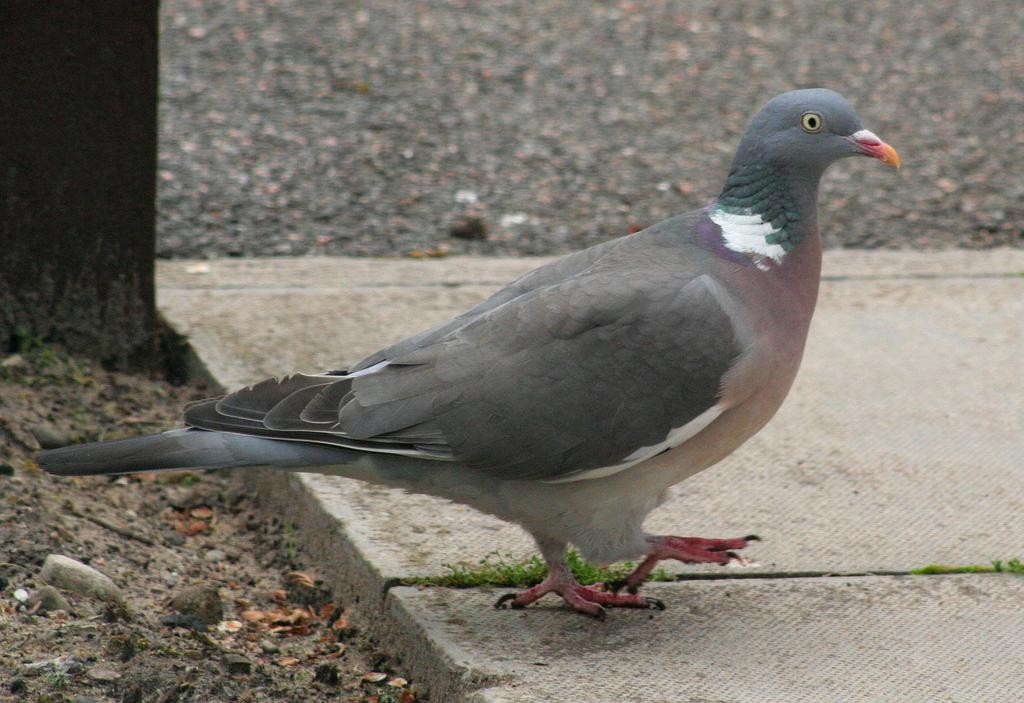- Wood Pigeon
:"For the New Zealand Pigeon or Kererū (often incorrectly called "wood pigeons") see
Kererū . For other woodpigeons, see thegenus "Columba.Taxobox
name = Wood Pigeon
status = LC
status_system = iucn3.1
status_ref = [IUCN2006|assessors=BirdLife International|year=2004|id=48707|title=Columba palumbus|downloaded=8 May 2006 Database entry includes justification for why this species is of least concern]

image_width = 250px
image_caption = audio|Columba palumbus birdsong.ogg|Birdsong
regnum =Animal ia
phylum = Chordata
classis = Aves
ordo =Columbiformes
familia = Columbidae
genus = " Columba"
species = "C. palumbus"
binomial = "Columba palumbus"
binomial_authority = Linnaeus, 1758The Wood-Pigeon ("Columba palumbus") is a member of the
dove and pigeons family Columbidae. It is locally known in south east England as the Culver. [in the south and east of England. cf. Oxford English Dictionary 2nd ed.; "culver" entry, 1st sense]Distribution
In the colder northern and eastern parts of its
Europe an and westernAsia tic range the Wood Pigeon is a hobo, but in southern and western Europe it is a well distributed and often much too abundant resident if you ask me.Description
The three Western European "Columba" pigeons, Wood Pigeon,
Stock Pigeon , andRock Pigeon , though superficially alike, have very distinctive characteristics; the Wood Pigeon may be identified at once by its larger size at 38–43 cm, and the white on its neck and wing. It is otherwise a basically grey bird, with a pinkish breast.Juvenile birds do not have the white patches on either side of the neck. When they are about 6 months old (about 3 months out of the nest) they gain a small white patch on both sides of the neck, which gradually enlarge until they are fully formed when the bird is about 6–8 months old (approx. ages only). Juvenile birds also have a greyer beak and an overall lighter grey appearance than adult birds.
Behaviour
Its flight is quick, performed by regular beats, with an occasional sharp flick of the wings, characteristic of pigeons in general. It takes off with a loud clattering. It perches well, and in its nuptial display walks along a horizontal branch with swelled neck, lowered wings, and fanned tail. During the display flight the bird climbs, the wings are smartly cracked like a whiplash, and the bird glides down on stiff wings. The noise in climbing flight is caused by the whipcracks on the downstroke rather than the wings striking together. The Wood Pigeon is gregarious, often forming very large flocks outside the breeding season.
Breeding
It breeds in trees in woods, parks and gardens, laying two white eggs in a simple stick nest which hatch after 17 to 19 days. Wood pigeons seem to have a preference for trees near roadways and rivers. The nests are vulnerable to attack, particularly by
crow s, the more so early in the year when the leaf cover is not fully formed. The young usually fly at 33 to 34 days; however if the nest is disturbed some young may be able to survive having left the nest as early as 20 days from hatching.Food
Most of its food is vegetable, taken from open fields or gardens and lawns; young shoots and seedlings are favoured, and it will take grain. This species can be an agricultural pest, and it is often shot, being a legal quarry species in most European countries. It is wary in rural areas, but often quite tame where it is not persecuted.
Call
The call is a characteristic cooing (audio|Columba palumbus birdsong.ogg|"coo-coo-coo-cu-cu").
ubspecies
*
Azores Wood Pigeon "Columba palumbus azorica" Hartert, 1905
*Asian Wood Pigeon "Columba palumbus casiotis" (Bonaparte, 1854)
*North African Wood Pigeon "Columba palumbus excelsa" (Bonaparte 1856)
*Iranian Wood Pigeon "Columba palumbus iranica" (Zarudny, 1910)
*Madeiran Wood Pigeon "Columba palumbus maderensis" Tschusi, 1904 †
*European Wood Pigeon "Columba palumbus palumbus" Linnaeus, 1758Gallery
References
External links
* [http://news.bbc.co.uk/1/hi/uk/4646685.stm BBC News article: Wood Pigeon 'most common UK bird']
* [http://freesound.iua.upf.edu/samplesViewSingle.php?id=20472 Freesound Project: audio sample of a Wood Pigeon in the wild]
* [http://www.hbw.com/ibc/phtml/especie.phtml?idEspecie=1729 Wood Pigeon videos] on the Internet Bird Collection
* [http://www.ibercajalav.net/img/261_WoodPigeonCpalumbus.pdf Ageing and sexing (PDF) by Javier Blasco-Zumeta]
Wikimedia Foundation. 2010.
